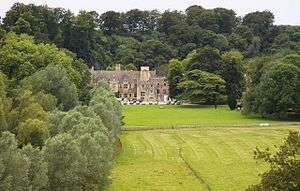Bibury Court
Bibury Court is a Grade I listed Jacobean country house in Bibury, Gloucestershire, England.[1]

The River Coln flows to the south of the property.[2]
History
The house was built between 1560 and 1599,[3] and was first extended in 1633 for Sir Thomas Sackville.[4] Later additions have since been made and the 16th-century building now forms the north wing. The Sackville family including their heirs the Cresswells owned it until 1816 when it was sold to Lord Sherborne.[3] Thomas Estcourt Cresswell had the interior remodelled around 1759.[1]
Sir Orme Clarke Bt CBE bought the house in the 1920s along with most of the surrounding Bibury estate from Lords Sherbourne and lived there with his wife Elfrida (née Roosevelt). The House was sold by the Sir Humphrey Clarke Bt in 1963 following the death of his mother but he, and later his son, Sir Tobias Clarke Bt, retained the Court Estate until the 1980s. The Northern portion of the estate known as Kilkenny Farm was sold to S. J. Phillips & Sons (Kemble) Ltd who had been tenant farmers to the Clarke family.[3] The house was converted into a hotel in 1968, and back into a private home in 2015.[5]
Architecture
.jpg)
The house and outbuildings are of Cotswold stone.[3] The entrance walls and gateway date from the early 18th century.[6] The 16th century house now forms the north wing. The east front has a symmetrical centre with the north and south wings to either side.[1]
The estate includes over 100 acres (40 ha) of woodland, 119 acres (48 ha) of pasture and over 500 acres (200 ha) of arable farmland,[2] making a total of 762 acres (308 ha).[3]
The buildings on the estate include a 17th century Mill House[7] and 18th century dovecote.[8] The mill itself contains the original machinery over the mill race and a pump to supply water to theNew Barn.[2] The Court Farmhouse dates from the 17th century.[9] The stables are from the early 19th century,[10] although another former stable block from the late 16th century has been converted into a bar.[11]
References
- Historic England. "Bibury Court Hotel (Grade I) (1155708)". National Heritage List for England. Retrieved 28 October 2015.
- "The Bibury Court Estate" (PDF). On the Market. Retrieved 3 March 2020.
- Churchill, Penny (22 September 2016). "Country houses for sale in the Cotswolds". Country Life. Retrieved 3 March 2020.
- "Bibury Court hotel, Cotswolds, Gloucestershire". The Telegraph. Retrieved 25 May 2015.
- Archer, Megan (18 December 2014). "Bibury Court Hotel to be transformed into large country house due to business decline". Wilts and Gloucestershire Standard. Retrieved 3 March 2020.
- "Entrance walls and gateway approximately 120m to north of Bibury Court Hotel". National Heritage List for England. Historic England. Retrieved 3 March 2020.
- "Bibury Mill". National Heritage List for England. Historic England. Retrieved 3 March 2020.
- "Dovecote immediately north east of Court Farmhouse". National Heritage List for England. Historic England. Retrieved 3 March 2020.
- "Court Farmhouse". National Heritage List for England. Historic England. Retrieved 3 March 2020.
- "Outbuilding and stable approximately lOm north of Bibury Court Hotel". National Heritage List for England. Historic England. Retrieved 3 March 2020.
- "Coach House Bar approximately 50m north of Bibury Court Hotel". National Heritage List for England. Historic England. Retrieved 3 March 2020.
External links
| Wikimedia Commons has media related to Bibury Court. |